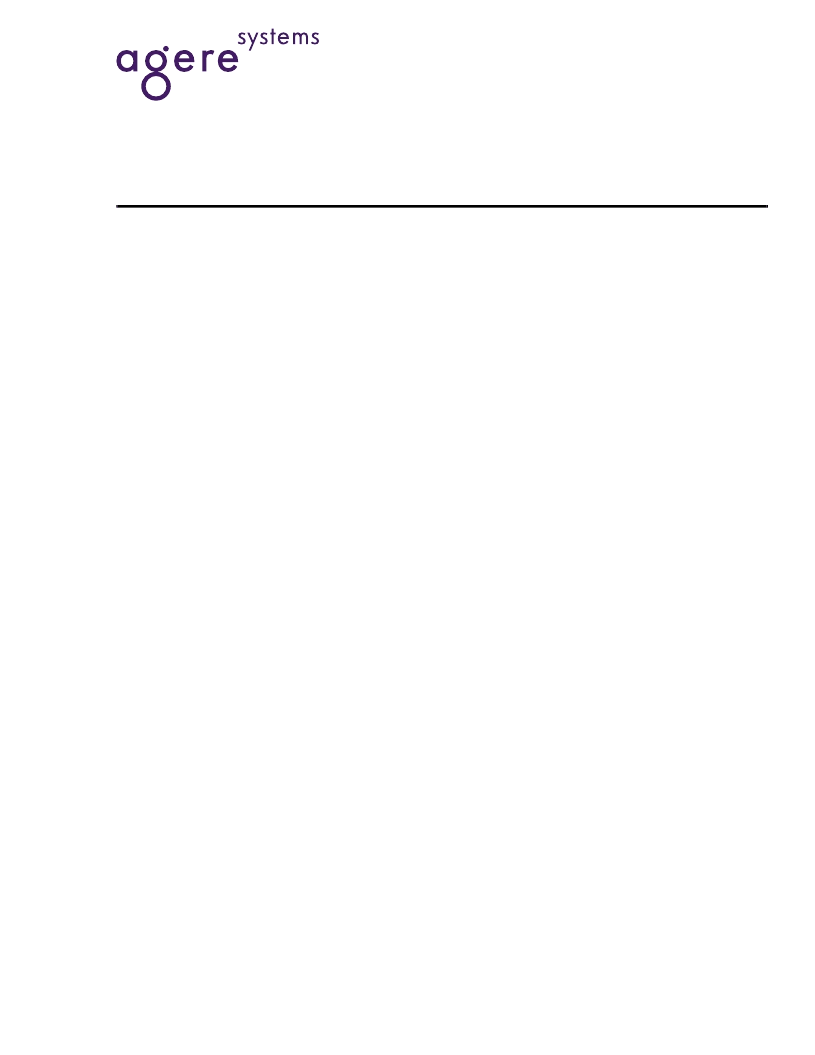- 您現(xiàn)在的位置:買賣IC網(wǎng) > PDF目錄367494 > L9500A High-Voltage Ringing SLIC for VolP Applications PDF資料下載
參數(shù)資料
| 型號: | L9500A |
| 英文描述: | High-Voltage Ringing SLIC for VolP Applications |
| 中文描述: | 高壓振鈴用戶接口應(yīng)用的福爾普 |
| 文件頁數(shù): | 1/32頁 |
| 文件大小: | 616K |
| 代理商: | L9500A |
當(dāng)前第1頁第2頁第3頁第4頁第5頁第6頁第7頁第8頁第9頁第10頁第11頁第12頁第13頁第14頁第15頁第16頁第17頁第18頁第19頁第20頁第21頁第22頁第23頁第24頁第25頁第26頁第27頁第28頁第29頁第30頁第31頁第32頁

Preliminary
Data Sheet
September 2001
L9500A
High-Voltage Ringing SLIC for VoIP Applications
L9500A Introduction
The Agere Systems Inc. L9500A is a subscriber line
interface circuit that is optimized for short-loop,
power-sensitive applications. This device provides
the complete set of line interface functionality (includ-
ing power ringing) needed to interface to a subscriber
loop. This device has the capability to operate with a
V
CC
supply of 3.3 V or 5 V and is designed to mini-
mize external components required at all device
interfaces. This device is optimized to interface to
data over cable service interface specification (DOC-
SIS) compliant cable modem gateway, multi-media
adaptor, and residential gateway products, such as
the Broadcom
BCM3351, BCM3352, BCM6352,
and BCM1101 and equivalent products.
Features
I
Differential ringing and codec interface
I
Onboard ringing generation
I
Three ringing input options:
— Sine wave
— PWM
— Logic level square wave
I
Flexible V
CC
options:
— 5 V or 3.3 V V
CC
— No –5 V required
I
Battery switch to minimize off-hook power
I
Eight operating states:
— Scan mode for minimal power dissipation
— Forward and reverse battery active
— On-hook transmission states
— Ground start
— Ring mode
— Disconnect mode
I
Ultralow on-hook power:
— 27 mW scan mode
— 38 mW active mode
I
Loop start, ring trip, and ground start detection
I
Software-controllable dual current limit option
I
28-pin PLCC package
I
48-pin MLCC package
Applications
I
Interface to
Broadcom
:
— BCM3351 Cable Modem
— BCM3352 Cable Modem
— BCM6352 Integrated Multi-Media Adaptor
— BCM1101 Residential Gateway
I
Cable Modem
I
Voice over Internet Protocol (VoIP)
I
Voice over DSL
I
Remote Subscriber Units
I
Broadband Wireless
I
Short Loop Access
Description
This device is optimized to provide battery feed, ring-
ing, and supervision on short-loop plain old tele-
phone service (POTS) loops.
This device provides power ring to the subscriber
loop through amplification of a low-voltage input. It
provides forward and reverse battery feed states, on-
hook transmission, a low-power scan state, ground
start (tip open), and a forward disconnect state.
The device requires a V
CC
and battery to operate.
V
CC
may be either a 5 V or a 3.3 V supply. The ring-
ing signal is derived from the high-voltage battery. A
battery switch is included to allow for use of a lower-
voltage battery in the off-hook mode, thus minimizing
short-loop off-hook power.
Ring mode overhead is collapsed, allowing rail-to-rail
operation. In this manner, the L9500 can operate
from a lower 75 V battery to minimize critical power
consumption and at the same time extend subscriber
ringing loop lengths to 500
and beyond.
Loop closure, ring trip, and ground start detection is
available. The loop closure detector has a fixed
threshold with hysteresis. The ring trip detector
requires a single-pole filter, thus minimizing external
components required.
The dc current limit is set and fixed by a logic-control-
lable pin. Ground or open applied to this pin sets the
current limit at the low or high value.
The device is offered with differential ringing and
receive input, making it ideal for direct interface to
DOCSIS compliant cable modem gateway products.
相關(guān)PDF資料 |
PDF描述 |
|---|---|
| L9653M | Analog IC |
| L9654M | Analog IC |
| L9700D | Analog IC |
| L9700 | HEX PRECISION LIMITER |
| L9705D | DOUBLE QUAD CONTACT INTERFACE CIRCUIT |
相關(guān)代理商/技術(shù)參數(shù) |
參數(shù)描述 |
|---|---|
| L9503 | 制造商:Leviton Manufacturing Co 功能描述: |
| L9505 | 制造商:Leviton Manufacturing Co 功能描述: |
| L9508 | 制造商:Leviton Manufacturing Co 功能描述: |
| L9509 | 制造商:Leviton Manufacturing Co 功能描述: |
| L-95-10 | 制造商:Hozan Tool Industrial Co Ltd 功能描述: |
發(fā)布緊急采購,3分鐘左右您將得到回復(fù)。